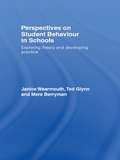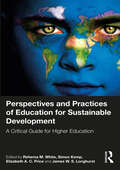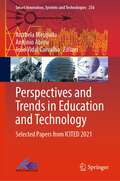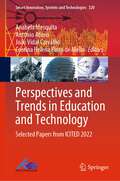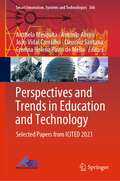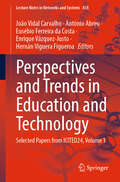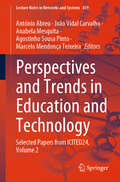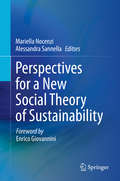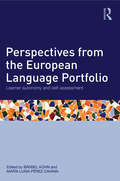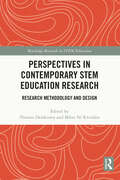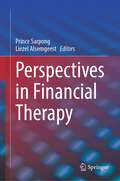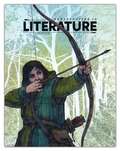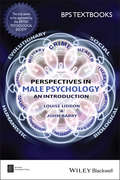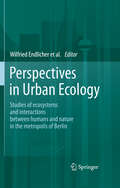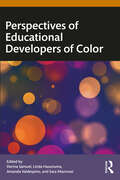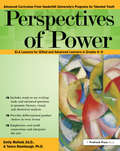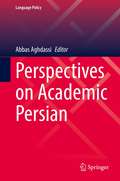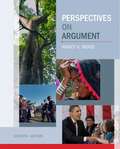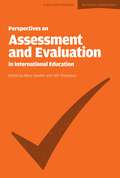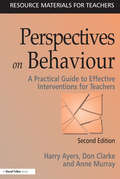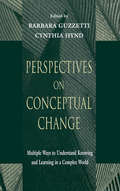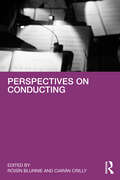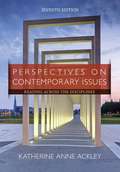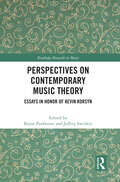- Table View
- List View
Perspectives on Student Behaviour in Schools: Exploring Theory and Developing Practice
by Janice Wearmouth Mere Berryman Ted GlynnThe authors of this comprehensive text discuss the root causes of disruptive behaviour, tackle assessment issues and develop effective intervention strategies that will be of practical use to teachers and other educators. Whilst theorising behaviour management from a range of perspectives: psychodynamic, behavioural and socio-cultural, the authors remain firmly focused on practical issues of policy making, assessment and intervention, and address a wide range of related issues, such as: policy in relation to behaviour in schools at local authority, national and international level cultural concerns, race, gender, school discipline and exclusion medical perspectives of topical interest such as ADHD, autism and diet assessment at district, community, classroom and individual level, and how these underpin theory. This book will appeal to anyone for whom behaviour in schools is a key concern, such as student teachers, teacher educators, senior school managers and practising teachers undertaking further study in the field.
Perspectives and Practices of Education for Sustainable Development: A Critical Guide for Higher Education
by Simon Kemp Rehema M. White Price, Elizabeth A. C. Longhurst, James W. S.Informed by theory and full of practical advice, this key title offers a clear route to education for sustainable development (ESD) whilst questioning how we reconcile participatory, inclusive processes and the urgency of global crises.This handbook provides guidance for those with an interest in the purpose and direction of learning and the principles and practices of sustainability in universities in the UK and beyond. With critical analysis and useful case studies and recommendations, the book covers key topics such as: The need for sustainable development and the role that universities can play in this Showing how ESD should be part of a whole institution approach Development of relevant curricula with innovative and inspiring pedagogies to support sustainability competencies Transdisciplinary learning and pioneering forms of knowledge production Graduate futures and emerging priorities in the field of ESD Through detailed case studies from experts in the field, this book demonstrates how ESD enables a critical interrogation of our world and strengthens the capacities of our universities to nurture future thinking leaders.This is essential reading for all those interested in beginning or widening ESD in programmes, universities and the wider sector, including academic staff, university senior managers and support staff, students, policy makers, employers, and community leaders.
Perspectives and Trends in Education and Technology: Selected Papers from ICITED 2021 (Smart Innovation, Systems and Technologies #256)
by Anabela Mesquita António Abreu João Vidal CarvalhoThis book presents high-quality, peer-reviewed papers from the International Conference in Information Technology & Education (ICITED 2021), to be held at the ESPM – Higher School of Advertising and Marketing, Sao Paulo, Brazil, between the 15th and the 17th of July 2021. The book covers a specific field of knowledge. This intends to cover not only two fields of knowledge – Education and Technology – but also the interaction among them and the impact/result in the job market and organizations. It covers the research and pedagogic component of Education and Information Technologies but also the connection with society, addressing the three pillars of higher education. The book addresses impact of pandemic on education and use of technology in education. Finally, it also encourages companies to present their professional cases which is discussed. These can constitute real examples of how companies are overcoming their challenges with the uncertainty of the market.
Perspectives and Trends in Education and Technology: Selected Papers from ICITED 2022 (Smart Innovation, Systems and Technologies #320)
by Anabela Mesquita António Abreu João Vidal Carvalho Cristina Helena Pinto de MelloThis book presents high-quality, peer-reviewed papers from the International Conference in Information Technology & Education (ICITED 2022), to be held at the ESPM – Higher School of Advertising and Marketing, Rio de Janeiro, Brazil, between July 14 – 16, 2022. This book covers a specific field of knowledge. This intends to cover not only two fields of knowledge – Education and Technology – but also the interaction among them and the impact/result in the job market and organizations. It covers the research and pedagogic component of Education and Information Technologies and also the connection with Society, addressing the three pillars of higher education. This book addresses impact of pandemic on education and use of technology in education. Finally, it also encourages companies to present their professional cases which will be discussed. These can constitute real examples of how companies are overcoming their challenges with the uncertainty of the market.
Perspectives and Trends in Education and Technology: Selected Papers from ICITED 2023 (Smart Innovation, Systems and Technologies #366)
by Anabela Mesquita António Abreu João Vidal Carvalho Cristina Helena Pinto de Mello Cleuciliz SantanaThis book presents high-quality, peer-reviewed papers from the International Conference in Information Technology & Education (ICITED 2023), to be held at the Nilton Lins University, Manaus, Brazil, during June 29–30, 2023. The book covers a specific field of knowledge. This intends to cover not only two fields of knowledge—Education and Technology—but also the interaction among them and the impact/result in the job market and organizations. It covers the research and pedagogic component of Education and Information Technologies but also the connection with Society, addressing the three pillars of higher education. The book addresses impact of pandemic on education and use of technology in education. Finally, it also encourages companies to present their professional cases which will be discussed. These can constitute real examples of how companies are overcoming their challenges with the uncertainty of the market.
Perspectives and Trends in Education and Technology: Selected Papers from ICITED24, Volume 1 (Lecture Notes in Networks and Systems #858)
by António Abreu João Vidal Carvalho Eusébio Ferreira da Costa Enrique Vázquez-Justo Hernán Viguera FigueroaThis book from the LNNS Series is composed of the best selected papers accepted for presentation and discussion at the 2024 International Conference in Information Technology & Education (ICITED’24). The ICITED is a multidisciplinary conference with a special focus on new Technologies and Systems in the Education sector and was held between July 11 and 13, 2024. The ICITED’24 was supported by the Pernambuco University, Recife, Brazil, and by IADITI—International Association for Digital Transformation and Technological Innovation. The International Conference in Information Technology & Education is an international forum for researchers and professionals in the education sector, which enables the discussion of the latest innovations, trends, and concerns in several areas, in the education sector, associated with information technologies and systems. It is an event for professionals in the sector, in search of technology solutions, where academics, IT experts, and business managers meet to discuss new ideas that help them maximize the potential of learning processes through technology. The ICITED’24 Scientific Committee is composed of a multidisciplinary group of 143 experts who assessed some 262 papers from 26 countries, received for each of the main topics proposed for the conference. The papers accepted for presentation and discussion at the conference are published by Springer and will be submitted for indexing by ISI, SCOPUS, EI-Compendex, Google Scholar, and SpringerLink.
Perspectives and Trends in Education and Technology: Selected Papers from ICITED24, Volume 2 (Lecture Notes in Networks and Systems #859)
by Anabela Mesquita António Abreu João Vidal Carvalho Agostinho Sousa Pinto Marcelo Mendonça TeixeiraThis book from the LNNS Series is composed of the best selected papers accepted for presentation and discussion at the 2024 International Conference in Information Technology & Education (ICITED’24). The ICITED is a multidisciplinary conference with a special focus on new Technologies and Systems in the Education sector and was held between July 11 and 13, 2024. The ICITED’24 was supported by the Pernambuco University, Recife, Brazil, and by IADITI—International Association for Digital Transformation and Technological Innovation. The International Conference in Information Technology & Education is an international forum for researchers and professionals in the education sector, which enables the discussion of the latest innovations, trends, and concerns in several areas, in the education sector, associated with information technologies and systems. It is an event for professionals in the sector, in search of technology solutions, where academics, IT experts, and business managers meet to discuss new ideas that help them maximize the potential of learning processes through technology. The ICITED’24 Scientific Committee is composed of a multidisciplinary group of 143 experts who assessed some 262 papers from 26 countries, received for each of the main topics proposed for the conference. The papers accepted for presentation and discussion at the conference are published by Springer and will be submitted for indexing by ISI, SCOPUS, EI-Compendex, Google Scholar, and SpringerLink.
Perspectives for a New Social Theory of Sustainability
by Mariella Nocenzi Alessandra SannellaThis ambitious book outlines the theoretical and practical implications of the recent technological revolution of human/non-human relations for social researchers, and in so doing, seeks to develop more adequate theoretical and methodological models for social scientists to describe and investigate these social transformations and their consequences. The environmental strategies to balance human actions with the earth’s resources utilizing a sustainable approach can inspire original conceptualizations and, therefore, a new sociological paradigm rooted in a necessary rethinking of the dualism between nature and culture, and of human relations in a hyper-connected society increasingly composed by non-human elements. Chapter discussions include: Sustainability and the crisis of the theoretical functional modelEnvironmental sustainability and the evolution of capitalismFrom moral imperatives to indicators and indices: a methodology for validating and assessing SDGsAn understanding of psychopathological syndromes related to social environmentsSocial research between participation and critical detachment Perspectives for a New Social Theory of Sustainability emphasizes that not only are modernist theories of unlimited wealth and progress no longer supportable, but also that their theoretical and empirical settings must be reassessed if society is to move towards sustainability. It promises to be required reading for students and researchers in sociology, psychology, economics and statistics, as well as professionals within government organizations and NGOs focused on human rights work, global inequities, ethical activism, and the UN Agenda 2030 and its Sustainable Development Goals."This book provides a unique toolkit for politicians and citizens on sustainable development and how it is fulfilled every day."David Maria SASSOLIEuropean Parliament President
Perspectives from the European Language Portfolio: Learner autonomy and self-assessment
by Bärbel Kühn María Luisa Pérez CavanaUsing constructivist principles and autonomous learning techniques the ELP has pioneered innovative and cutting edge approaches to learning languages that can be applied to learning across the spectrum. Although articles on the success of the ELP project have appeared in some academic journals, Perspectives from the European Language Portfolio is the first book to report on and contextualise the project’s innovative techniques for a wider educational research audience. During the last ten years the ELP has increasingly become a reference tool for language learning and teaching in primary, secondary and tertiary educational settings all around Europe. The editors of this volume believe that there is a need to reflect on the significant contribution that the ELP has delivered for language learning and teaching, and to critically evaluate its achievements. This volume offers a range of investigations from theoretical studies to practical cases around these issues, and includes: relevant contributions of the ELP to language pedagogy; assessing the impact of the ELP on pedagogical research and practice; exploring and defining pathways for future developments; Reflective learning. This book is intended for a readership of language teachers and researchers across Europe. It will be of particular relevance to those engaged in language learning and teaching within the Common European Framework of Reference, supporting independent learning and developing a language curriculum, whether in school, adult, further or higher education.
Perspectives in Contemporary STEM Education Research: Research Methodology and Design (Routledge Research in STEM Education)
by Thomas Delahunty Máire Ní RíordáinThis book presents an overview of the methodological innovations and developments present in the field of STEM education research as well as providing a practically orientated resource on research method design more broadly. Featuring a range of international contributors in the field, the book provides a compendium of exemplary innovative methodological designs, implementations, and analyses that answer a variety of research questions relating to STEM education disciplines. Charting the thinking behind the design and implementation of successful research investigations, the book’s two parts present an accessible and pragmatically framed set of chapters that cover a range of important methodological areas presented by active researchers in the field. Ultimately, this book presents a comprehensive resource that explores the act of educational research as related to STEM. By showcasing key methodological principles with guidance on practical approaches underpinned by theory, the book offers scholarly research-informed suggestions for practice. It will be of great interest to researchers, academics, and students in the fields of STEM education and education research methods, as well as educational research more broadly.
Perspectives in Financial Therapy
by Prince Sarpong Liezel AlsemgeestAs we deepen our understanding of the interplay between money and psychology, financial therapy has emerged as a popular field of study. This book offers a diverse range of perspectives on the practice of financial therapy, exploring its benefits, challenges, and potential critiques. The book also provides practical guidance for financial therapists as well as financial planning and mental health practitioners who incorporate financial therapy into their work. The book covers a wide range of topics, including the neurobiology of financial decision-making, models in financial therapy, online financial therapy, generational differences in financial attitudes, incorporating financial therapy into divorce planning, and techniques for coping with the stresses associated with estate planning. The book addresses the need for culturally relevant assessments of financial therapy in African contexts and offers a critical appraisal of the field of financial therapy. By providing multiple perspectives and practical guidance, this book will be a valuable resource for students, scholars, and researchers in financial therapy, financial planning and related fields, as well as the broader field of psychology.
Perspectives in Literature
by Bju PressBJU Press Perspectives in Literature Grade 6: Student Text (3rd Edition)
Perspectives in Male Psychology: An Introduction (BPS Textbooks in Psychology)
by John Barry Louise LiddonPERSPECTIVES IN MALE PSYCHOLOGY Discover a balanced perspective on men’s psychology in this accessible new resource Male psychology is a new field within the discipline of psychology, which focuses on men and boys. Male psychology moves us towards a more scientific and balanced understanding of the psychology of men and of boys, drawing on a range of perspectives, and away from an overreliance on social constructionism and preoccupations with notions such as patriarchy and privilege, too often seen in the narrative about men. In Perspectives in Male Psychology: An Introduction, two of the most prominent authors in this new field, Louise Liddon and John Barry, introduce and deliver an insightful exploration of some of today’s most hotly contested issues regarding men and masculinity. This book puts forward a balanced perspective that has been missing from academic and media narratives around topics such as child development, education, sport and exercise, the workplace, crime, the military, health and wellbeing, mental health, therapy, masculinity, and sex differences, and considers the role that evolution, biology, and culture play in shaping male behavior. This book will also help readers to better understand some key issues such as: Why there are controversies around sex differences research How bias in research has led to a distorted view of the psychology of men and boys The ways in which the mental health and other needs of men and boys are routinely overlooked In turn this helps us ask some important questions such as: If there are more similarities than differences between men and women, does that mean the differences are unimportant? How can we un-distort our understanding of men and masculinity? What are the best ways of identifying and meeting the psychological needs of men and boys? Readers, whether students or lecturers, will also benefit from the inclusion of our companion Wiley website containing additional resources to support the development of knowledge and understanding of male psychology. Perfect for undergraduate and graduate students in psychology, medicine, and sociology, as well as established professionals in these and related fields, Perspectives in Male Psychology: An Introduction will also earn a place in the libraries of anyone interested in the psychology of sex and gender differences in various aspects of mental health and human behaviour.
Perspectives in Urban Ecology
by Wilfried EndlicherThis book gives an interdisciplinary overview on urban ecology. Basic understanding of urban nature development and its social reception are discussed for the European Metropolitan Area of Berlin. Furthermore, we investigate specific consequences for the environment, nature and the quality of life for city dwellers due to profound changes such as climate change and the demographic and economic developments associated with the phenomena of shrinking cities. Actual problems of urban ecology should be discussed not only in terms of natural dimensions such as atmosphere, biosphere, pedosphere and hydrosphere but also in terms of social and cultural dimensions such as urban planning, residence and recreation, traffic and mobility and economic values. Our research findings focus on streets, new urban landscapes, intermediate use of brown fields and the relationships between urban nature and the well-being of city dwellers. Finally, the book provides a contribution to the international discussion on urban ecology.
Perspectives of Educational Developers of Color
by Derina Samuel Linda Hasunuma Amanda Valdespino Sara MazroueiThis seminal collection of essays captures and celebrates the distinct insights, experiences, and accomplishments of educational developers of color (EDC) across the USA and Canada.Perspectives of Educational Developers of Color is the first volume to focus on the growing number of EDC, their stories, career trajectories, and contributions in the field. EDC often provide support for students, faculty, and staff of color while also responding to the ever-evolving needs of the institution to create a more equitable, inclusive, and accessible environment.In highlighting the perspectives of EDC across diverse, intersecting identities, this text brings to the forefront strategies that institutions can implement to strengthen their support and cultivate a sense of belonging in their communities.
Perspectives of Power: ELA Lessons for Gifted and Advanced Learners in Grades 6-8
by Tamra Stambaugh Emily MofieldWinner of the 2015 NAGC Curriculum Studies Award Perspectives of Power explores the nature of power in literature, historical documents, poetry, and art. Lessons include a major focus on rigorous evidence-based discourse through the study of common themes and content-rich, challenging nonfiction and fictional texts. This unit, developed by Vanderbilt University's Programs for Talented Youth and aligned to the Common Core State Standards (CCSS), guides students to explore the power of oppression; the power of the past, present, and future; and the power of personal response by engaging in simulations, skits, creative projects, literary analyses, Socratic seminars, and debates. Texts illuminate content extensions that interest many high-ability students including bystander effect, social class structure, game theory, the use and abuse of technology, cultural conflict, the butterfly effect, women's suffrage, and surrealism as each relates to power. Lessons include close readings with text-dependent questions, choice-based differentiated products, rubrics, formative assessments, and ELA writing tasks that require students to analyze texts for rhetorical features, literary elements, and themes through argument, explanatory, and/or prose-constructed writing. Ideal for pre-AP and honors courses, the unit features texts from Emily Dickinson, William B. Yeats, and Charles Perrault; art from Moyo Okediji and Salvador Dali; and speeches by Elie Wiesel, Susan B. Anthony, and John F. Kennedy. As a result from the learning in the unit, students will be able to examine powerful influences in their own lives and identify their own power in personal responsibility. Grades 6-8
Perspectives on Academic Persian (Language Policy #25)
by Abbas AghdassiThis book focuses on the idea of Academic Persian in the growing competition of many Middle Eastern languages to produce and highlight their academic discourse. Similar to academic English, most West Asian languages including Persian, Turkish, and Arabic are developing new styles and genres to produce academic texts. The book addresses a major question: "What is academic Persian?" Intended for researchers, experts, analysts, policy-makers, and students in Persian, Iranian studies, and Islamic studies, as well as Near Eastern languages and Middle Eastern cultures and languages, the book includes numerous technical contributions on the emerging markets involving west Asian languages. Since indexing, abstracting, crawling, metrics, citations, and visibility are becoming hot issues for academics, service providers (e.g., publishers) and policy-makers (e.g., university heads), a knowledge of academic Persian will help readers to grasp what Persian, and other similar languages, require in academic markets.
Perspectives on Argument (7th Edition)
by Nancy V. WoodThis combination rhetoric/reader helps readers develop strategies for critical reading, critical thinking, research, and writing that will help the reader argue clearly and convincingly. It teaches them to identify and develop arguments, to read and form reactions and opinions of their own, to analyze an audience, to seek common ground, and to use a wide, realistic range of techniques to write argument papers that express their individual views and original perspectives on modern issues.
Perspectives on Assessment and Evaluation in International Schools (World Class Schools)
by Mary Hayden Jeff ThompsonAssessment and evaluation are two concepts at the core of schooling which are also central to other forms of education worldwide. In an international context, assessment and evaluation data are increasingly widely used for accountability and quality assurance purposes at individual student, institutional, national and global levels. This book does not attempt to include consideration of all the issues that could possibly be covered in a title that addresses assessment and evaluation in education internationally. Nor has it set out to cover the myriad technical issues with which assessment and evaluation are inevitably concerned. Rather, a number of authors working within different contexts of international education (whether as teachers or leaders in international schools, administrators in international examination bodies, or researchers in international educational research organisations) have been invited to share ideas arising from their own experiences of what might be interpreted as assessment or evaluation, be that assessment of student achievement, evaluation of teacher effectiveness or evaluation of school quality. The international dimension presents a range of challenges to those with responsibility for implementing assessment and evaluation strategies in widely diverse linguistic, cultural, social and personal contexts, and in this book valuable contributions are shared by colleagues who are authorities in the field. It is their personal views on assessment and evaluation, derived from professional practice in the international sphere, that have been brought together here.
Perspectives on Assessment and Evaluation in International Schools (World Class Schools)
by Mary Hayden Jeff ThompsonAssessment and evaluation are two concepts at the core of schooling which are also central to other forms of education worldwide. In an international context, assessment and evaluation data are increasingly widely used for accountability and quality assurance purposes at individual student, institutional, national and global levels. This book does not attempt to include consideration of all the issues that could possibly be covered in a title that addresses assessment and evaluation in education internationally. Nor has it set out to cover the myriad technical issues with which assessment and evaluation are inevitably concerned. Rather, a number of authors working within different contexts of international education (whether as teachers or leaders in international schools, administrators in international examination bodies, or researchers in international educational research organisations) have been invited to share ideas arising from their own experiences of what might be interpreted as assessment or evaluation, be that assessment of student achievement, evaluation of teacher effectiveness or evaluation of school quality. The international dimension presents a range of challenges to those with responsibility for implementing assessment and evaluation strategies in widely diverse linguistic, cultural, social and personal contexts, and in this book valuable contributions are shared by colleagues who are authorities in the field. It is their personal views on assessment and evaluation, derived from professional practice in the international sphere, that have been brought together here.
Perspectives on Behaviour: A Practical Guide to Effective Interventions for Teachers (Resource Materials For Teachers Ser.)
by Anne Murray Harry Ayers Don ClarkeThis book is a practical guide to the following eight perspectives on behaviour: biological - focusing on biological and biochemical processes in accounting for behaviour; behavioural (or behaviourist) - focusing on overt, observable and measurable behaviours and their reinforcement in accounting for behaviour; cognitive (or cognitive-behavioural) - focusing on cognitive processes (beliefs, attitudes, expectations and attributions) in accounting for behaviour; combines both the cognitive and the behavioural perspective; social learning - focusing on observational learning, perceived self-efficacy and expectancies in accounting for behaviour; psychodynamic - focusing on unconscious conflicts in early childhood as accounting for current behaviour; humanistic - focusing on low self-esteem and problems in coping with and exploring feelings in accounting for behaviour; ecosystemic - focusing on positive and negative interactions between teachers and students within the school and those that externally affect the school; these interactions are seen as accounting for behaviour; ecological - focusing on the influence of systems and the environment in accounting for behaviour. The aim of the book is to enable the reader to develop a structured approach to emotional and behavioural problems by drawing on one or more of the above perspectives.
Perspectives on Conceptual Change: Multiple Ways to Understand Knowing and Learning in a Complex World
by Barbara Guzzetti Cynthia HyndPerspectives on Conceptual Change presents case study excerpts illustrating the influence on and processes of students' conceptual change, and analyses of these cases from multiple theoretical frameworks.Researchers in reading education have been investigating conceptual change and the effects of students' prior knowledge on their learning for more than a decade. During this time, this research had been changing from the general and cognitive--average effects of interventions on groups of students--to the specific and personal--individuals' reactions to and conceptual change with text structures. Studies in this area have begun to focus on the social, contextual, and affective influences on conceptual change. These studies have potential to be informed by other discourses. Hence, this book shows the results of sharing data--in the form of case study excerpts--with researchers representing varying perspectives of analyses. Instances of learning are examined from cross disciplinary views. Case study authors in turn respond to the case analyses. The result is a text that provides multiple insights into understanding the learning process and the conditions that impact learning.
Perspectives on Conducting
by Róisín Blunnie Ciarán CrillyRooted in research and practice, Perspectives on Conducting presents a multi-faceted exploration of the role of the modern-day conductor. Seeking to bring a more inclusive approach to understanding conducting as a career, this book expands beyond elite pathways to highlight the contributions made by conductors across different areas of musical engagement, including youth projects, community groups, and professional ensembles. Chapters by an international roster of authors address the challenges conductors face in working with a wide range of ensembles, including orchestras and choirs made up of young people, university and conservatory students, adult volunteers, and professional musicians.The contributors draw on their experience and expertise as practising conductors and scholar-practitioners to explore both the core musical responsibilities and the additional administrative and social demands placed on today’s conductors. With topics including pathways to conducting careers, the creative role of the conductor in shaping new music, conducting mixed-ability ensembles, the experiences of women and queer conductors, and more, the perspectives collected here reflect the versatility required of the contemporary conductor, giving students and emerging professionals a forward-thinking view of the conductor’s role.
Perspectives on Contemporary Issues: Reading Across Disciplines (Seventh Edition)
by Katherine Anne AckleyPERSPECTIVES on CONTEMPORARY ISSUES, 7th Edition, approaches learning as the interconnectedness of ideas and disciplinary perspectives. This cross-disciplinary reader encourages critical thinking and academic writing by presenting a variety of perspectives on current issues across the curriculum.
Perspectives on Contemporary Music Theory: Essays in Honor of Kevin Korsyn (Routledge Research in Music)
by Jeffrey Swinkin Bryan ParkhurstKevin Korsyn is a renowned music theorist, musicologist, and pedagogue who has taught at the University of Michigan since 1992. He has published widely and influentially in areas as diverse as Beethoven and Brahms studies, chromatic tonality, disciplinarity and metatheory, history of theory, musical meaning and hermeneutics, poststructuralism (deconstruction, intertextuality, etc.), and Schenkerian theory and analysis. Because of the scope and caliber of his published work, and also his legacy as a pedagogue, Korsyn has had a profound impact on the field of music theory, along with the related fields of historical musicology and aesthetics. This book, a festschrift for Korsyn, comprises essays that constellate around his numerous scholarly foci. Represented in the volume are not only familiar music-theoretical topics such as chromaticism, form, Schenker, and text-music relations, but also various interdisciplinary topics such as deconstruction, disability studies, German Idealism, posthumanism, and psychoanalysis. The book thus reflects the increasingly multifaceted intellectual landscape of contemporary music theory.
